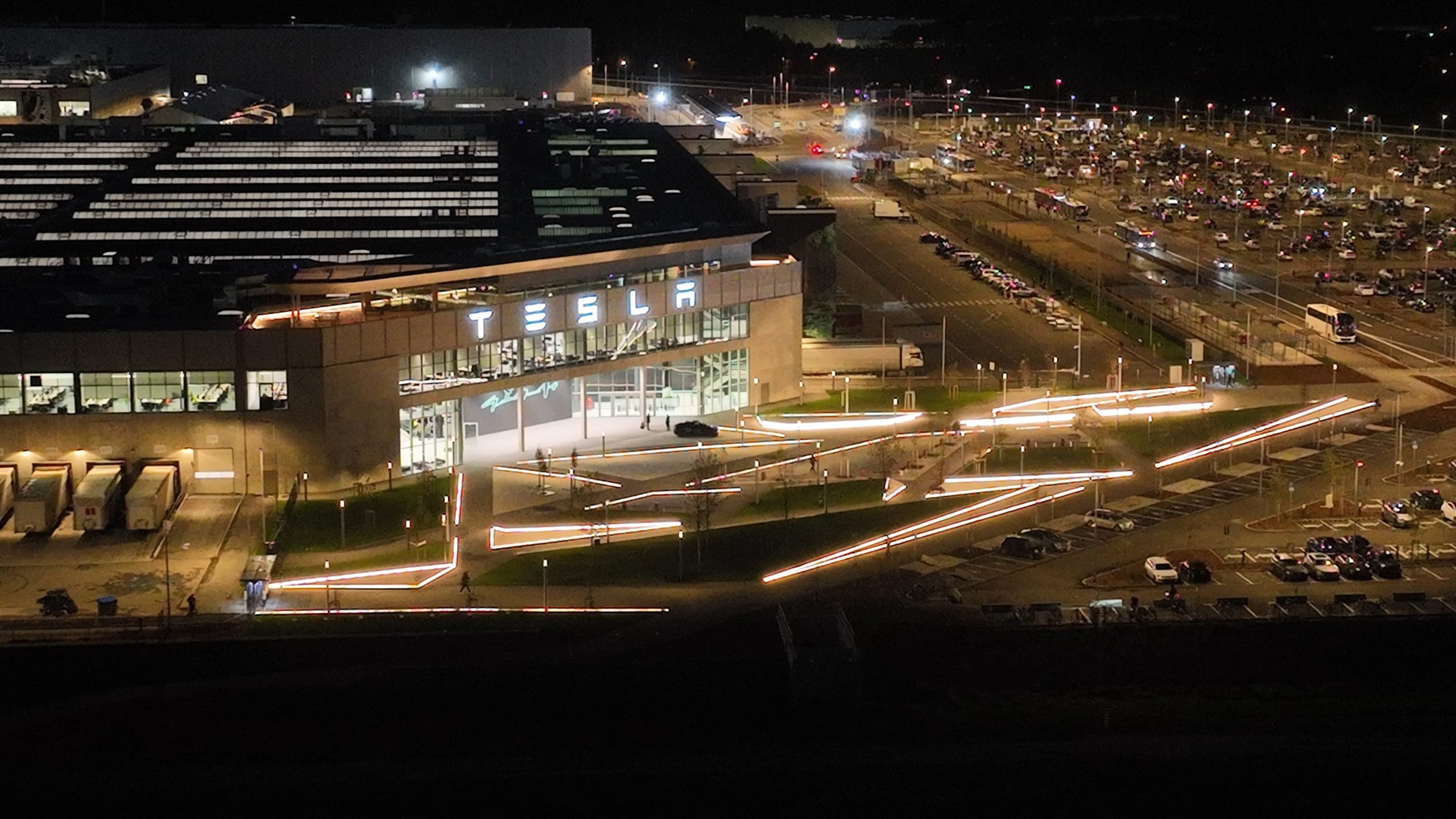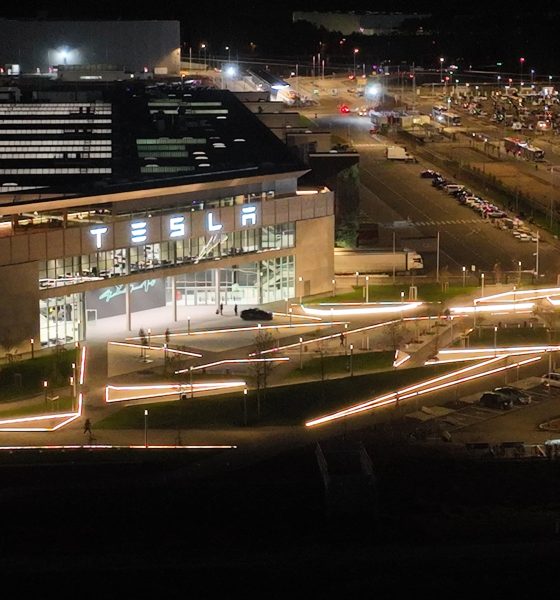

News
Anti-Tesla protestors call for gradual dismantling of Giga Berlin: “expropriate, strike, loot”
Over the weekend, groups of Tesla protesters and supporters held events against and in support of Gigafactory Berlin-Brandenburg. A look at the messaging in each event shows that Tesla may have its work cut out for it if it wants to convince its critics that the Grünheide-based Model Y factory is a net positive for the region.
Following the forced shutdown of Giga Berlin due to a suspected arson attack on a power pylon, Tesla employees at Giga Berlin took a stand against the company’s critics. Gathering around Giga Berlin with lights in their hands, the Tesla employees pledged to stand strong and come back from the alleged arson stronger than before. Tesla critics, for their part, organized a protest against Tesla on Sunday.
Lights On pic.twitter.com/3Py4BERjfK— Tesla Manufacturing (@gigafactories) March 8, 2024
As noted in a report from BZ, the anti-Tesla protesters on Sunday numbered about 800. The group, which was reportedly comprised of leftists, environmentalists, and masked anarchists, demanded that Tesla be stopped and Giga Berlin be demolished. Amidst Palestinian scarves, Antifa, and Kurdistan flags, some banners from the group read, “Don’t demand, fight. Expropriate, strike, loot.”
Over a loudspeaker system powered by a diesel generator, Lou Winters, who is from the Tesla den Hahn abdrehen (Turn off Tesla’s tap) group, also called for a “gradual dismantling” of the Tesla Model Y factory. Other discussions from the protesters included complaints about capitalism, colonialism, and Tesla CEO Elon Musk.
Hundreds of Environmental Activists Protest in Germany Against Tesla's Expansion Plans for 'Gigafactory'#BNN #Worldnews #Dailynews #Breakingnews #Newsupdate #Germany #Grünheide #Savetherainforest #Tesla #Gigafactory pic.twitter.com/ve2hzI4nHN— Nitish Verma (@nitsonnet) March 11, 2024
Tesla supporters, for their part, supported Tesla’s presence in Grünheide through a counter-protest. Organizer Albrecht Köhler noted during the demonstration that the community wants Tesla in the area. “We want a future with Tesla here. This is an important settlement, we can’t turn back anymore,” Köhler said.
Tesla supporter Silas Heineken noted on X that while the anti-Tesla protest was much larger than the pro-Giga Berlin counter-protest, those who attended the pro-Tesla event were almost all Grünheide residents. Participants of the anti-Tesla protests were reportedly eco-activists from all over Germany.
Grünheider residents fighting full time Againsters supporting "the current thing" with peace and techno.
Big thanks to everybody who joined to stop this irrationalism! We are not alone. pic.twitter.com/uu1uLtxO3S— Silas Heineken (@silasheineken) March 10, 2024
BZ noted that the police have so far filed some criminal charges during the anti-Tesla demonstration. Three were reportedly apprehended because they were masked, and another reportedly gave a banned Hitler salute to a group of protesters. Reports and videos also seemed to depict YouTube streamer Björn Banane and his wife and dog being attacked by protesters with sticks and other objects.
Don’t hesitate to contact us with news tips. Just send a message to simon@teslarati.com to give us a heads up.

News
Tesla starts showing how FSD will change lives in Europe
Local officials tested the system on narrow country roads and were impressed by FSD’s smooth, human-like driving, with some calling the service a game-changer for everyday life in areas that are far from urban centers.

Tesla has launched Europe’s first public shuttle service using Full Self-Driving (Supervised) in the rural Eifelkreis Bitburg-Prüm region of Germany, demonstrating how the technology can restore independence and mobility for people who struggle with limited transport options.
Local officials tested the system on narrow country roads and were impressed by FSD’s smooth, human-like driving, with some calling the service a game-changer for everyday life in areas that are far from urban centers.
Officials see real impact on rural residents
Arzfeld Mayor Johannes Kuhl and District Administrator Andreas Kruppert personally tested the Tesla shuttle service. This allowed them to see just how well FSD navigated winding lanes and rural roads confidently. Kruppert said, “Autonomous driving sounds like science fiction to many, but we simply see here that it works totally well in rural regions too.” Kuhl, for his part, also noted that FSD “feels like a very experienced driver.”
The pilot complements the area’s “Citizen Bus” program, which provides on-demand rides for elderly residents who can no longer drive themselves. Tesla Europe shared a video of a demonstration of the service, highlighting how FSD gives people their freedom back, even in places where public transport is not as prevalent.
What the Ministry for Economic Affairs and Transport says
Rhineland-Palatinate’s Minister Daniela Schmitt supported the project, praising the collaboration that made this “first of its kind in Europe” possible. As per the ministry, the rural rollout for the service shows FSD’s potential beyond major cities, and it delivers tangible benefits like grocery runs, doctor visits, and social connections for isolated residents.
“Reliable and flexible mobility is especially vital in rural areas. With the launch of a shuttle service using self-driving vehicles (FSD supervised) by Tesla in the Eifelkreis Bitburg-Prüm, an innovative pilot project is now getting underway that complements local community bus services. It is the first project of its kind in Europe.
“The result is a real gain for rural mobility: greater accessibility, more flexibility and tangible benefits for everyday life. A strong signal for innovation, cooperation and future-oriented mobility beyond urban centers,” the ministry wrote in a LinkedIn post.
News
Tesla China quietly posts Robotaxi-related job listing
Tesla China is currently seeking a Low Voltage Electrical Engineer to work on circuit board design for the company’s autonomous vehicles.

Tesla has posted a new job listing in Shanghai explicitly tied to its Robotaxi program, fueling speculation that the company is preparing to launch its dedicated autonomous ride-hailing service in China.
As noted in the listing, Tesla China is currently seeking a Low Voltage Electrical Engineer to work on circuit board design for the company’s autonomous vehicles.
Robotaxi-specific role
The listing, which was shared on social media platform X by industry watcher @tslaming, suggested that Tesla China is looking to fill the role urgently. The job listing itself specifically mentions that the person hired for the role will be working on the Low Voltage Hardware team, which would design the circuit boards that would serve as the nervous system of the Robotaxi.
Key tasks for the role, as indicated in the job listing, include collaboration with PCB layout, firmware, mechanical, program management, and validation teams, among other responsibilities. The role is based in Shanghai.
China Robotaxi launch
China represents a massive potential market for robotaxis, with its dense urban centers and supportive policies in select cities. Tesla has limited permission to roll out FSD in the country, though despite this, its vehicles have been hailed as among the best in the market when it comes to autonomous features. So far, at least, it appears that China supports Tesla’s FSD and Robotaxi rollout.
This was hinted at in November, when Tesla brought the Cybercab to the 8th China International Import Expo (CIIE) in Shanghai, marking the first time that the autonomous two-seater was brought to the Asia-Pacific region. The vehicle, despite not having a release date in China, received a significant amount of interest among the event’s attendees.
Elon Musk
Elon Musk and Tesla AI Director share insights after empty driver seat Robotaxi rides
The executives’ unoccupied tests hint at the rapid progress of Tesla’s unsupervised Robotaxi efforts.

Tesla CEO Elon Musk and AI Director Ashok Elluswamy celebrated Christmas Eve by sharing personal experiences with Robotaxi vehicles that had no safety monitor or occupant in the driver’s seat. Musk described the system’s “perfect driving” around Austin, while Elluswamy posted video from the back seat, calling it “an amazing experience.”
The executives’ unoccupied tests hint at the rapid progress of Tesla’s unsupervised Robotaxi efforts.
Elon and Ashok’s firsthand Robotaxi insights
Prior to Musk and the Tesla AI Director’s posts, sightings of unmanned Teslas navigating public roads were widely shared on social media. One such vehicle was spotted in Austin, Texas, which Elon Musk acknowleged by stating that “Testing is underway with no occupants in the car.”
Based on his Christmas Eve post, Musk seemed to have tested an unmanned Tesla himself. “A Tesla with no safety monitor in the car and me sitting in the passenger seat took me all around Austin on Sunday with perfect driving,” Musk wrote in his post.
Elluswamy responded with a 2-minute video showing himself in the rear of an unmanned Tesla. The video featured the vehicle’s empty front seats, as well as its smooth handling through real-world traffic. He captioned his video with the words, “It’s an amazing experience!”
Towards Unsupervised operations
During an xAI Hackathon earlier this month, Elon Musk mentioned that Tesla owed be removing Safety Monitors from its Robotaxis in Austin in just three weeks. “Unsupervised is pretty much solved at this point. So there will be Tesla Robotaxis operating in Austin with no one in them. Not even anyone in the passenger seat in about three weeks,” he said. Musk echoed similar estimates at the 2025 Annual Shareholder Meeting and the Q3 2025 earnings call.
Considering the insights that were posted Musk and Elluswamy, it does appear that Tesla is working hard towards operating its Robotaxis with no safety monitors. This is quite impressive considering that the service was launched just earlier this year.








